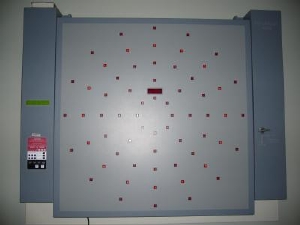Apr 21 2008
The standard eye chart only covers letters and numbers, but athletes need above average vision to track balls hurtling toward them at alarming speeds. To test those special skills, a University of Houston optometrist has founded the Sports Vision Performance Center, a facility where athletes perform while a strobe light is flashing, play tag with a board of lights and engage in other activities designed to improve their visual abilities.
 The Dynavision is a peg board that requires athletes to hit the red buttons as they light up. The Sports Vision Performance Center uses the machine to determine reaction time, peripheral awareness and accuracy of movement. (Credit: Photo courtesy of University Eye Institute.)
The Dynavision is a peg board that requires athletes to hit the red buttons as they light up. The Sports Vision Performance Center uses the machine to determine reaction time, peripheral awareness and accuracy of movement. (Credit: Photo courtesy of University Eye Institute.)
“The biggest problem that athletes face is not knowing they can potentially see much better than 20/20 vision,” said Kevin Gee, a Fellow of the American Academy of Optometry and an assistant clinical professor with the UH College of Optometry. Gee opened the Sports Vision Performance Center in January to individual athletes and teams from various sports, and utilizes a range of tests to analyze what is called the “visual system.”
“The visual system is more than just ‘what’s the smallest line on the chart you can see,’” Gee said. “The visual system consists of many things, but specifically for sports, depth perception, color, speed and accuracy of movements and contrast sensitivity – or the ability to detect an object off a background.”
To assess these skills, Gee and his staff use instruments, such as a 3-D movie projected on a computer screen with shimmering objects that pop up to measure depth perception, a lighted batting test that can time up to one-thousandth of a second to gauge timing and accuracy, and a Dynavision™ board – a vertical lighted peg board – that determines reaction time, peripheral awareness and accuracy of movement.
Gee has worked with several amateur and professional sports clubs and has been testing the skills of the UH women’s softball team since 2006. Some initial meetings during the 2006-07 season turned into weekly meetings during the offseason to test, train and condition the female athletes and their eyes in preparation for the 2007-08 season.
“We started out by examining every player on the team,” Gee said. “Through our testing methods, we identified where improvements in the visual system could be made. We timed the player’s swings to see if they were ahead or slightly behind. We customized the tests to focus on vision skills needed for infielders versus outfielders, and batters versus pitchers. Most importantly, we were able to enhance their vision with different shades, filters and correction through sports-specific eyewear.”
UH softball coach Kyla Holas jumped at the opportunity to work with Gee and his staff, and believes her team’s efforts now will pay off in the long run.
“The eye is a very intricate thing and although the differences are slight, I think it is one of those things that we have improved,” Holas said. “From his in-office tests to the field tests, the girls love the challenge and the way he presents the tests.
“We had to make some sacrifices in order to make this happen, but I would absolutely recommend this training for other teams,” Holas said.
April is Sports Eye Safety Month and Gee’s clinic is open to both individual athletes and teams as new patients. Along with softball and baseball, Gee has developed tests for tennis, football and soccer players. Gee hopes that ultimately his clinic will improve performance, but athletes must not neglect the need for eye protection.
“The easiest way to protect your eyes as an athlete is to get regular eye exams and to wear proper eye protection, as well as sunglasses, if needed,” Gee said. “A lot of athletes think polarized sunglasses are the way to go, but those are really for water sports or driving. The best types for athletes are impact resistant and sports-specific with a wraparound design to reduce the light but not the entire glare. Some athletes actually use the shadows and the reflection of the ball off the grass to see it better.”
To provide the best eye protection for athletes, Gee also spends time educating the athletics trainers and sports medicine groups on how to distinguish eye injuries, which can range from scratches, pokes or the simple loss of a contact lens, and how to treat those injuries while on the field.